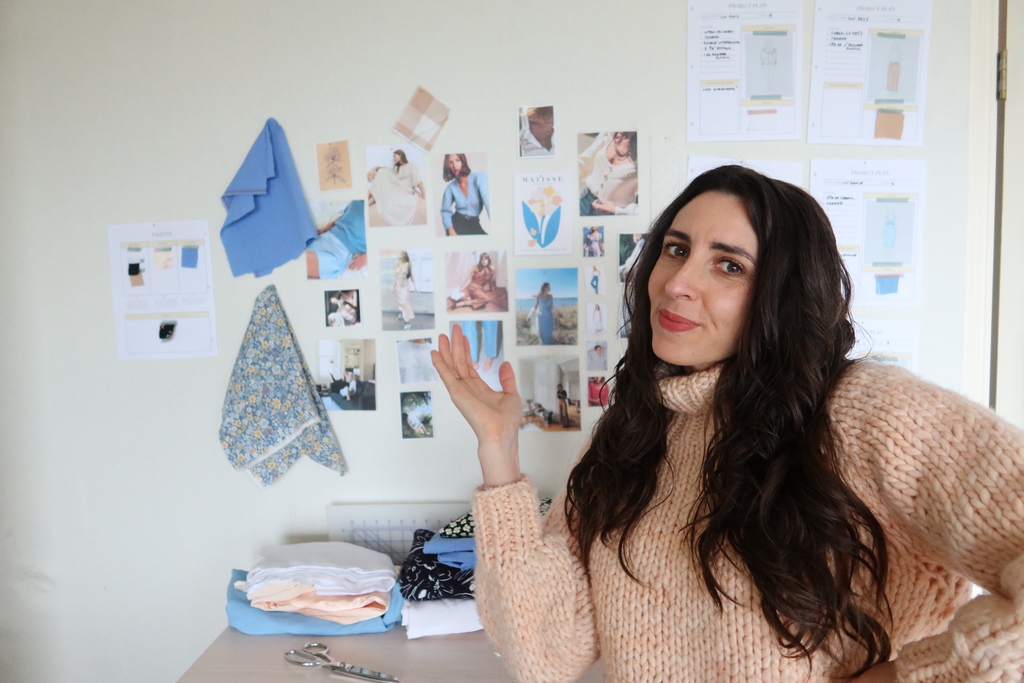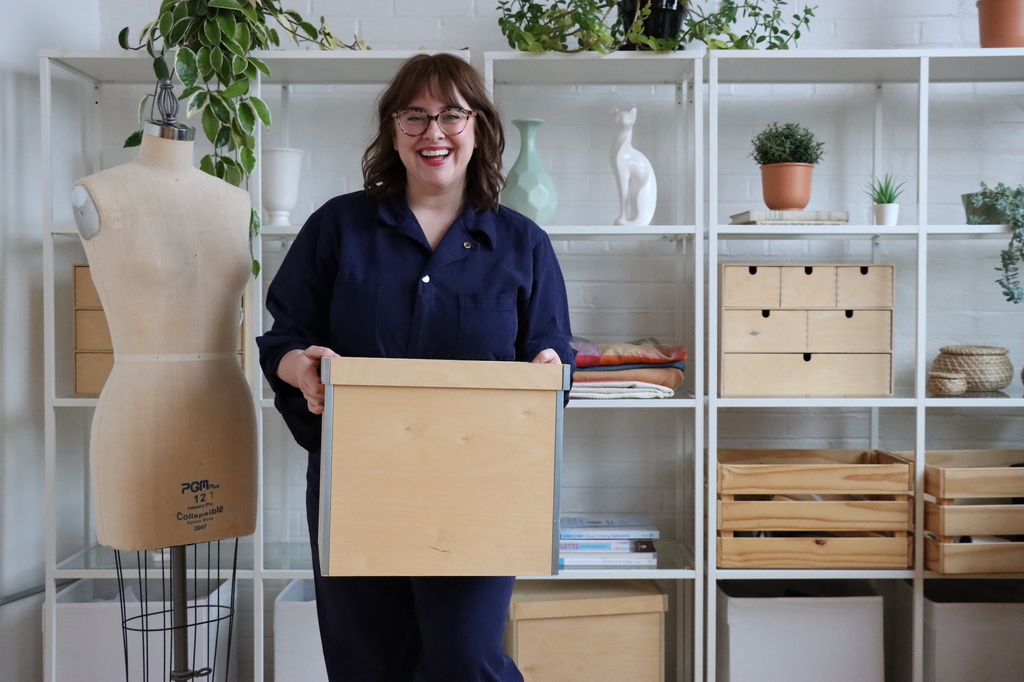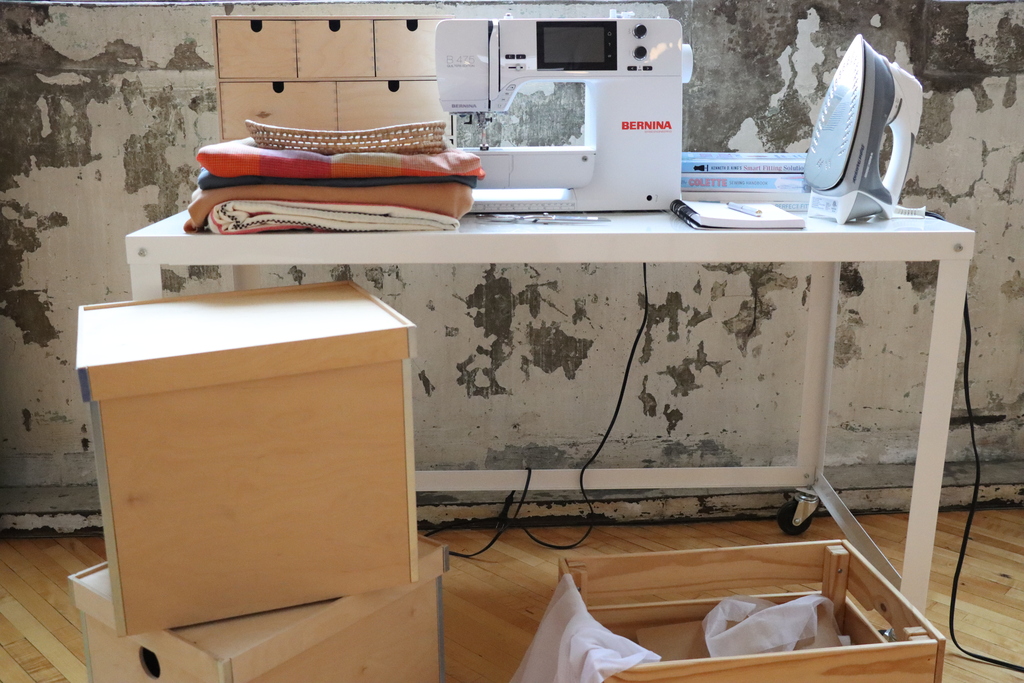Below are all the links in the show notes and a full, annotated transcript so you can easily follow the whole episode.
Podcast Transcript
Sarai
I'm Sarai.
Haley
And I'm Haley.
Sarai
And this is Seamwork Radio. Welcome back to Seamwork Radio, where we share practical ideas for building a creative process so you can sew with intention and joy.
Today, we're talking about how to revolutionize your sewing space. So we're going to cover how to figure out what the biggest problems are in your space, and then we're going to go over concrete ideas you can use for fixing each of those issues.
So we're going to start with our icebreaker for today. And our icebreaker is: what is bringing you creative joy right now?
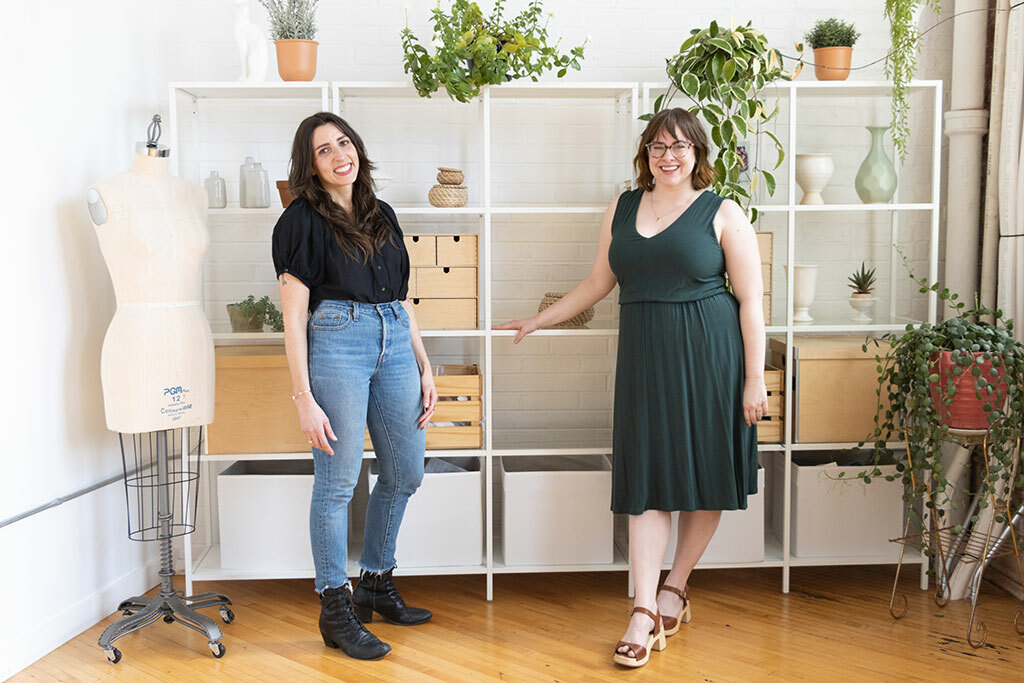
Icebreaker: What is bringing you creative joy right now?
Haley
I have a lot of little creative projects going that I'm having a lot of fun with. What comes to mind, though, is that I've been working on my plans for my 2023 garden, and all of my seeds are ordered, and everything is coming to life.
We're going to be building the raised beds in the yard, and I have a shed that's going in this week, and so it’s really exciting to see. Even though I'm not even doing some of these things myself, someone else is building the shed. It's nice to see all of the work and planning I've been doing coming to life and becoming real, which just has me, like, really excited for spring. Which might backfire on me because we had kind of have a little ways to go before it's, like, properly spring. We're recording this in mid-January, but I'm really excited about that, and that's bringing me some creative joy and also has me thinking about, like, spring sewing and spring socializing and all the fun things that we get to do in spring.
So that's what's bringing me some joy right now. What about you?
Sarai
Yeah, I think that's one of the fun parts of winter is just planning, getting all your plans in place for later in the year. I don't know. That's fun, too.
For me, I think what's bringing me creative joy right now, I'm doing some of the same things, so that's part of it. But I think the biggest thing right now is I'm learning how to use Procreate on my iPad to do drawing. And I got an Apple Pencil. I just have an iPad mini, like, an old one, and so I got the older Apple Pencil, pretty inexpensive, so I'm learning how to draw with it on my iPad, and it's been really fun.
I've been doing some drawings that I'm pretty happy with that I spent a long time on, and some that I did that I'm still struggling with a little bit, but I'm learning a lot, and that's been really, really fun. And what I would like to do is design some textiles and have them printed with Spoonflower so I can maybe in the summer make, like, a dress with some fabric that I've designed myself. I think that would be really fun.
Haley
We'll have to add that to the Seamwork shop on Spoonflower.
Sarai
Yeah. I've always wanted to design some fabrics because I'm really interested in, for some reason, I don't know, there's something about designing repeating patterns. I took a class on it several years ago at the local art college, and I just think it's so fun to design repeating patterns because it's different from just drawing or creating an illustration or something like that because you have to imagine it in repeat, and I think there's so many different variations. It's just really fun. So I'm enjoying that a lot.
Haley
That's fun. Patterns are fun because it's a little bit mathematical, too, and strategic. So you get to use both parts of your brain.
Sarai
Yeah, and there's a lot of different styles. I like a more scattered pattern a lot of times on clothing at least, but I also like the really packed ones, like all the Liberty florals and things like that. There's just so many different styles, so it's going to be fun to play around with it once I get a little bit better at actually drawing on the iPad.
So that's what's bringing me creative joy right now. I think that if you have an icebreaker for us, you should definitely leave it for us at here because we're always looking for more icebreakers and we will probably use it on a future episode. So thank you to everybody who's left them for us already, and we would love to hear yours.
73% of you stop sewing because of your physical sewing space
All right, so let's get into today's topic. So we did this survey a while back and we found that 73% of the sewers that we surveyed told us that their physical space stops them from sewing. So think about that. The majority of us are held back from a creative hobby that we love simply because of our environment.
So we're going to talk about how to identify what bothers you the most about your sewing space, and then we're going to share some ways to make it better.
By identifying your top pain points in your sewing space and then working on those specifically, you can really make the biggest impact. That's what we're going to talk about today.
Let's start with talking about our spaces. So what do you love about your sewing space?
Haley
Hailey I think that what I love about my sewing space is—my desk is right in front of a window and I love the view out that window. It's not anything super fancy. I can see some trees, though, and it's pretty. And having that light right on my workspace, it's like good serotonin, good feelings when I sit there. That is probably what I love most about my space, because I only moved into my current spot six months ago, so it's definitely a work in progress. But that is the one thing I know for sure. It's staying. I'm keeping it that way.
Sarai
Yeah. Light is so important in the sewing space. It's so nice to have the benefit of natural light, if you have that.
Haley
Yeah, it really affects your mood.
Sarai
Yeah, I find that to be the case.
We're in my sewing space right now as we're recording this. And I, too, have windows all along one side, and I have a great view out the windows and lots of light, which is really nice. It's a little hard in the summer, I'll admit, because it gets so hot in here. Really hot. So that's a little bit of a problem. But overall, this is Oregon, so it's usually not hot. That's one of the things that I really love about my sewing space.
The other thing that I really love about this space is that—I think I've mentioned this probably to you guys before—but when we moved into this house, we bought this house about a year and a half ago. The previous owner was a quilter, and she and her husband were downsizing and moving into another place, and she didn't want to keep some of her sewing furniture, so she just left it with the house for me. She asked me if I wanted it. So my desk, and I have a Koala cabinet, which is one of those cabinets that folds out and holds a whole bunch of sewing stuff and also folds out into a cutting table.
And she left that for me in my big L-shaped sewing desk, which has a drop down for the sewing machine. And it's really a nice set up. Not something I would have bought for myself by any means. Like, I never would have spent the money to buy this, but she just gave it to me, which is amazing. So that's another thing.
She also has a big—she converted one of the walls into a pin board. She covered it in batting. It's not the entire wall, but it's like half the wall is covered in batting. So I use that for my mood boards and things, which is also really cool and amazing. I don't know that I would have done that on my own. So it was just like, all set up for me, which is really cool.
Haley
It's very cozy.
Sarai
It is cozy. It is really nice. I love it. I love it here.
What do you prioritize in your sewing space?
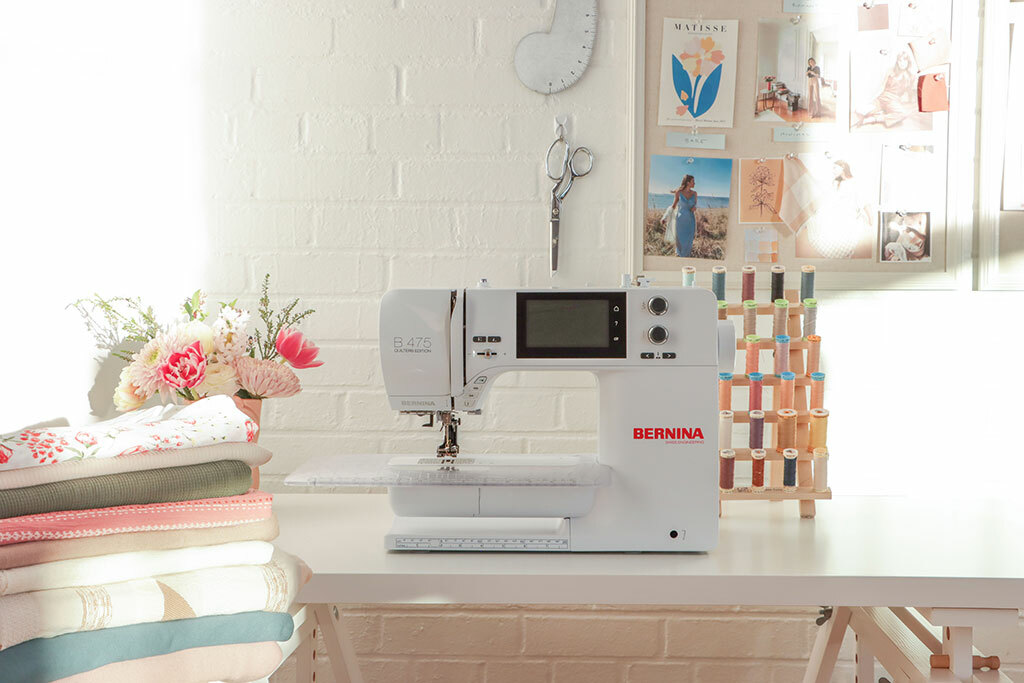
Haley
What do you tend to prioritize when it comes to creating your sewing space?
Sarai
For me, I would say storage is one thing. Definitely making sure that I have accessible storage, making sure my patterns of my fabric have homes, especially. I have a lot of patterns, especially vintage patterns, and I like to keep them organized or I know I won't use them. So making sure that I have things organized in such a way that they're actually going to get used, I think is probably my top priority. And then after that, I would say just making it feel like a place where I want to be.
What about you?
Haley
It's very practical that you prioritize storage. I feel like in the past I have, but my current sewing space is—it’s the first time I've ever had a space that was dedicated to sewing. I was always on a dining room table or it was my husband and mine's office and a guest room. We’re just, like, very multipurpose.
So I think my first priority in this case was I just wanted it to be kind of cute. I didn't have a ton of money up front, but I was like, I'm going to buy a cute rug. I'm going to hang some curtains, and I'm going to hang a quilt on the wall, and it's going to be cute, because this feels like the biggest luxury in the world right now. And I just needed to honor that in a way.
Sarai
Yeah, I think that's one reason why I'm so adamant about storage, because I've always been in either a hybrid space—this is actually still a hybrid space because it's also my office and also a guest room—but I've always either been in a hybrid space or at my dining room table, or we had a little nook in our kitchen in our old, old house, and keeping things tidy and out of sight was really important. I'm not a super tidy person. I wouldn't say probably average at best, but that's kind of made me into a tidier person when it comes to sewing stuff.
Haley
Yeah, definitely. I'm like a fairly tidy person. So storage has always been my priority. But just recently I've been like, no, it needs to be cute. That's the priority right now. And I'll work on storage later.
Is there anything that peeves you about your sewing space?
What peeves you about your sewing space?
Sarai
There's a couple of small things that do. One is that this room is carpeted, and that's not so great for sewing because threads get everywhere and it can be hard to clean. You can't just sweep it up. You have to vacuum. And especially when you have animals, you don't want them to eat the thread. So it can be a little bit of a cleanup issue.
Also, I like to use rolling chairs when I sew, and so I had to get some mats to put over the carpet so I could actually roll the chairs on the carpet. It's still kind of hard to move them around. So that's a little bit of an annoyance. Because I'm filming a lot of YouTube videos now at home, there's not a lot of, like, blank wall space or wall space generally in this room. So that's a little bit of an issue. But they're all pretty minor, I would say, with the actual space.
I do have some peeves around the way—I have not put in enough effort in organizing this space in the way that I would like. Yeah, but that's more like things I would like to change.
What about you?
Haley
That is a good question. I think what peeves me most about my sewing space is that I live in a house that was built in the forties. There are two outlets in the whole room and they're very inconveniently placed, and so I have to have some extension cords running. This is such a minor tiny thing, but it's the first thing my eye zeros in on when I walk into the room. And I feel like I'm just always having to negotiate what can be plugged in and what can't be plugged in and, oh, if the serger is plugged in, then I can't have my light plugged in. It's just kind of annoying. That is like just a highly specific peeve of mine.
Sarai
Yeah, I feel like all these things, they might feel minor in a lot of ways, but they're the kinds of things that do make you feel like your space is not optimal and they're little tiny roadblocks to doing what you want to do.
Haley
It definitely stops me from sewing late at night because I'm like, well, I can't have my serger and my machine plugged in and have the light, which I obviously need to sew. I probably could figure out something, but it might not be like super fire-safe.
Sarai
Just keep an eye on it, don't leave it.
Haley
I know, I mean, it is minor, but it is an annoyance that probably that stops me from sewing at times when I could be getting some sewing done.
Sarai
Yeah, I think actually thinking about it, I would say that that's another issue that I have is the fact that this is a hybrid space and so it is also my office and also a guest room. The guest room part is just when people are here, which is not very often, but the fact that it's my office means that I have to juggle papers and work stuff and I have my notebooks around and all kinds of pens and stuff. And I have to manage all of that along with the sewing stuff. So that can cause more of a mess, which kind of gets in the way of sewing sometimes. And I think probably a lot of people have that situation where you're using your sewing space for something else at the same time and that can be like a little bit of juggling.
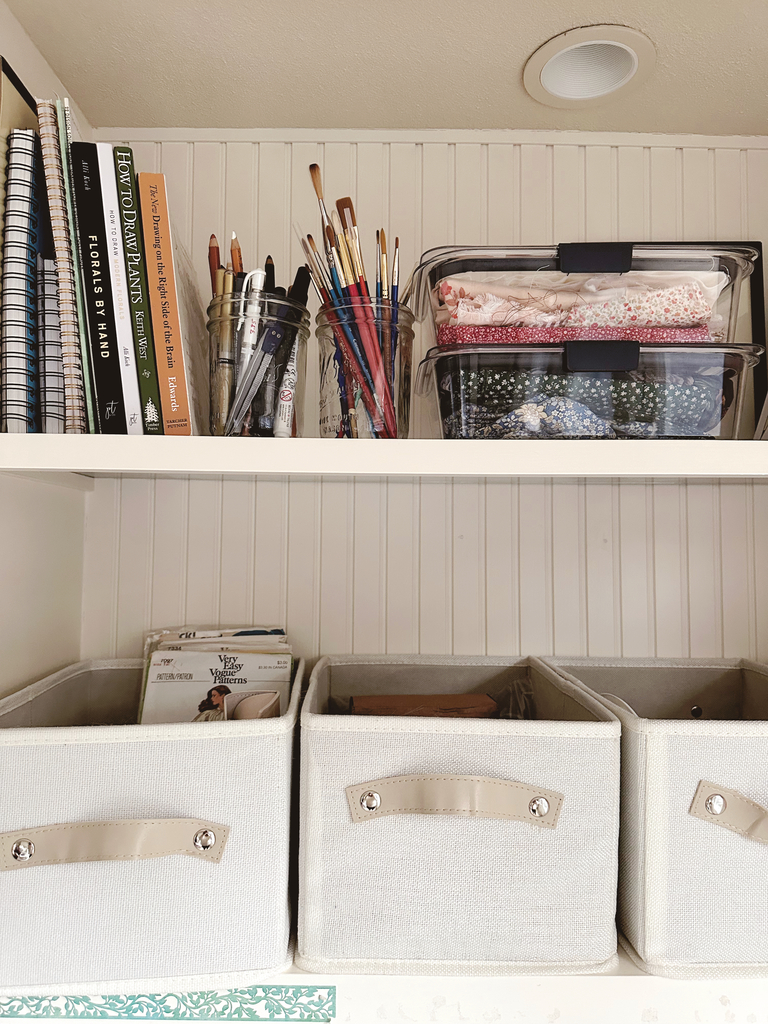
Haley
Yeah, I might have to take back that my space is not a hybrid space because it is actually my office as well that I work out of every single day. And since I'm in charge of the photo shoots that we do here at Seamwork, it is like a shipping center in my office. It's just all of the fabrics that we ordered for the samples. So there is like a little bit of juggling stuff. Just stuff everywhere.
Sarai
The space would be great if it wasn't for stuff in it.
Haley
This stuff is really ruining everything.
Tips for revolutionizing your sewing space
Sarai
All right, so let's talk about some tips. So we mentioned before that the way we're approaching this is to think about what the biggest problems in your space are. We'll start with that, and we're going to talk about some of the problems that you might have, and then we'll go through some possible solutions you could try or maybe just think about experimenting with to help you solve those problems.
Pain point: The amount of physical space
Sarai
So the first one we want to start with is if the amount of physical space is your biggest pain point, then we're going to share some things you can do. So if you feel like you just do not have enough space to work in, obviously I can't wave a magic wand and give you more space. But there are creative ways to work in almost any size space. And we even have a Seamworker who sews in their closet. It's not even a walk-in closet.
Haley
It's impressive.
Sarai
Just a closet, which is pretty amazing.
So if somebody can sew in their closet, you can probably find enough space to make it work. So some tips if this is the issue that you struggle with.
First of all, going back to what I said is keeping things organized but accessible. And one of the ways you can do this is actually keeping things on carts. I find carts to be a really awesome way to corral things and also keep them nearby when you need them. IKEA has a really, I don't know if they still sell it. I'm sure they still do. That really cute little cart. A lot of people have it in their sewing and their craft spaces. And actually it looks really cute when it's all full of sewing stuff or craft stuff.
Haley
And you just roll it into a closet when you're done. I think it's really good for that, like accessible short-term storage. Put your unfinished projects in it, put your tools you use all the time.
Sarai
Yeah, and actually it looks good. And it's got a pretty small footprint, too, which is nice. So carts like that are really helpful.
Kind of related to that, you can put things on casters, too. If you have a piece of furniture already that you want to use, you can add casters to it and make it easy to move around so that it's not always in your space. So that's another option. I know this is like a luxury to have this koala cabinet, but it is on casters, so I can roll it up against the wall. I can fold it in, roll it against the wall. It doesn't take up a lot of space. And then when I need a cutting table, I roll it out and I can unfold it and have a big cutting table. So that's really, really nice.
Make sure that your most frequently used tools and equipment are the easiest to access—that’s really important. So if you're short on space and you need to keep some things hidden, it's really helpful just to have the most frequently used stuff available to you.
So that goes back to the accessibility thing. And I think that is super, super helpful when you don't have a lot of space. Like I was saying before, most of the time I've been sewing, I did not have very much space at all. And making sure that those things, like, for example, my rotary cutter, my shears for cutting fabric, my iron, all those things that I'm going to use every single time are available to me was really helpful.
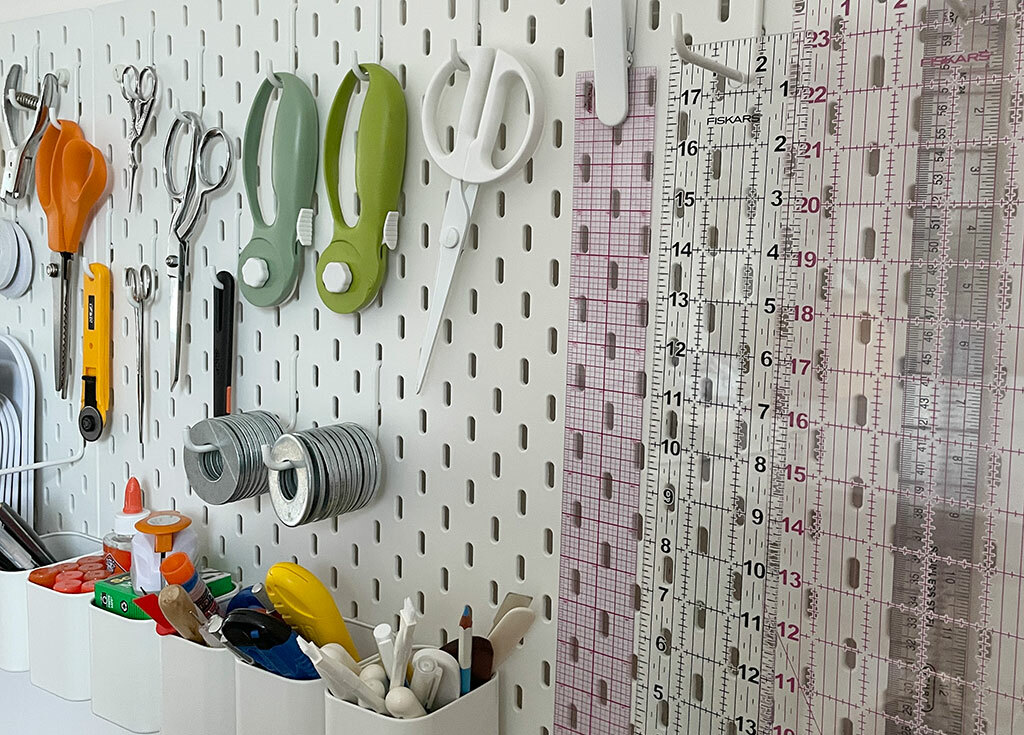
You can also take advantage of vertical space. So if you have vertical space to play with, this is a great small-space solution generally. So just something people use when they live in small spaces a lot. And it works in your sewing room. So if you can mount things on the wall, like pegboard—a pegboard can hold so much stuff. It's kind of incredible. And I think they look really cute, too. They have that really nice workshop look to them. So I don't know. It's inspiring to look at your wall of tools, I think.
Another thing is that there are some unexpected places that you can find storage. So just always be looking for storage. You can find storage under the bed, under the couch, inside an ottoman. There are a lot of ottomans that actually have storage inside them. So there's a lot of unexpected places where you can just hide your stuff when you're not using it.
Haley and I have both mentioned that we keep stuff in our garage, like fabric that we're not using at the moment. So that's another option. There are all kinds of places you can keep things that will be out of sight that you might not be using right now.
And then another tip is if small space is a concern for you, it can be helpful to clean your space after every sewing session. That will just help you to feel like things are not quite so chaotic. So we have an episode (episode 101), which is going to tell you how to do this in just 15 minutes. How to clean your space in 15 minutes. And I find that really helpful.
I get stressed out if my space is messy. When I've been in smaller spaces, I would say it's doubly stressful. So I think that's a really important one.
And going back to the first tip about the carts, and I mentioned my koala cabinet, I will also say, thinking about that, one of the places I lived in before where I had very little sewing space, I also had one of those folding tables. It's like a folding breakfast table from IKEA that was on casters. And it folds up really small, but the leaves fold out. You can put a cutting mat on it. And it was just the right size for cutting and it took up almost no space. And it had drawers in it. So a very cheap alternative to something like a koala cabinet.
Haley
Yeah, I used to have a butcher block that was on casters that I had in my kitchen, and I would use it for kitchen stuff. But also I could flip the leaves up and use it to cut, put my iron, because I had one of those little tabletop ironing boards. I just rolled it over when I was sewing. And it was like really great to have a little multipurpose piece of furniture that I could use in my day to day life, but also for sewing.
Sarai
Yeah, I bet you could find some vintage pieces on Craigslist or Facebook Marketplace or something like that too, that have leaves. Just look for things that have leaves or fold-out options.
Haley
I got mine for free. My in laws were cleaning out the garage and I was like, give me that. I drove it down to Los Angeles from Southern California. And it followed me. I still have it—all the way up to Portland.
Sarai
All right, so that was about physical space. If you don't have enough physical space, the next one is if a lack of proper tools is your main problem, then we're going to talk about how to upgrade your tools and equipment.
Pain point: Your don’t have the right tools and equipment
Sarai
So the first thing you could do, if this is an issue for you, is get an adjustable-height table that's large enough for cutting fabric. And the reason we mentioned that is because even though a table like that is big, it means that you don't need a second table, which is really nice. So if you get something that you can adjust the height, then you can use it for both cutting and for your other sewing tasks. And I think that's a really nice way. It actually saves space, if you have enough space for a large table because you don't need both. So I think that's a really great way that you can upgrade your space if you have the room for it.
Another really cool upgrade that you can make if you don't have it already is getting a serger. A serger is just going to transform your sewing, especially if you like to sew with knits and you don't have one yet. A serger can really eliminate a lot of the frustrations with sewing knits. It just makes it really fast, really easy, and you can use it to get a clean finish on your woven garments as well. So if you have the room and you have the budget for it, it is definitely an upgrade that is well worth it for a lot of people.
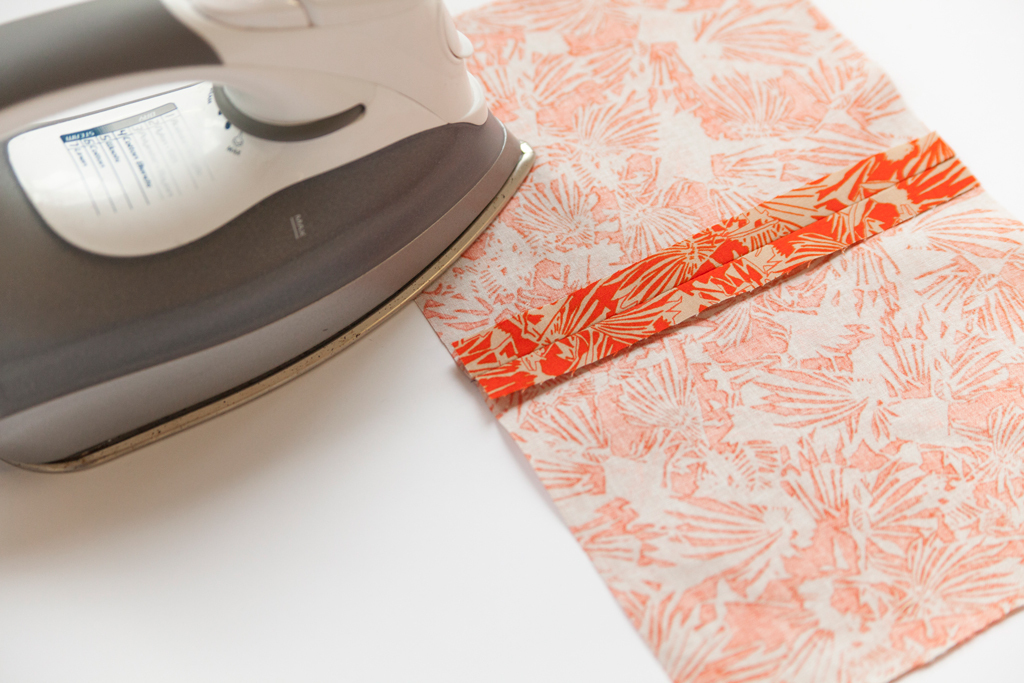
The next thing you can invest in is pressing tools. We talked a lot about pressing tools in episodes 106 and 107, where we cover 20 essential tools to have. So if you haven't listened to those episodes, and upgrading your tools is something that you're interested in—you want to kind of invest in better tools—those are really good ones to listen to.
Think about what pressing tools you already have and how you can upgrade them. So that would include your iron, maybe your ironing board, other pressing tools like a tailor's ham or a seam roll, if you don't have those already, they’re really, really good investments that don't necessarily cost a lot of money. Bang for your buck. Those are the ones to go with tf you're just looking to spend a little bit of money and really upgrade both your sewing and also, I think, your sewing experience, I think you're just going to enjoy pressing a lot more. Pressing is a huge part of getting the result you want in sewing. So definitely recommend that.
Then the last thing you could do, or you can consider, I guess, in terms of upgrading your stuff is a dress form. I don't have a dress form here personally. We have them at the office, obviously, but here I don't have one yet. But I've been thinking about getting one. I think it would be helpful.
Haley
It would be nice.
Sarai
It's a nice to have, for sure. So we have an article called Dress Forms and Mannequins that helps you weigh the pros and cons. So if you're interested in that, you could check that out. Do you have a dress form at home?
Haley
I do have a dress form. I got it for free. There was a place that was getting rid of a bunch of stuff, and so I nabbed this the last day of their studio sale. Nabbed this dress form. It's really beat up.
Sarai
Is it your size? It just happened to be your size?
Haley
It is a dress form, size 14, which is more of a regular size ten. So I can pad it out to make it more my size. And I have done that in the past. I actually really don't use mine super often anymore. I used to use it more when I would drape more frequently, but I just don't drape so much anymore. But it is kind of like, nice to have that option. I feel like I use it a lot when I'm letting things hang before I hem them. And I want it to be on a three-dimensional form. I think sometimes that helps.
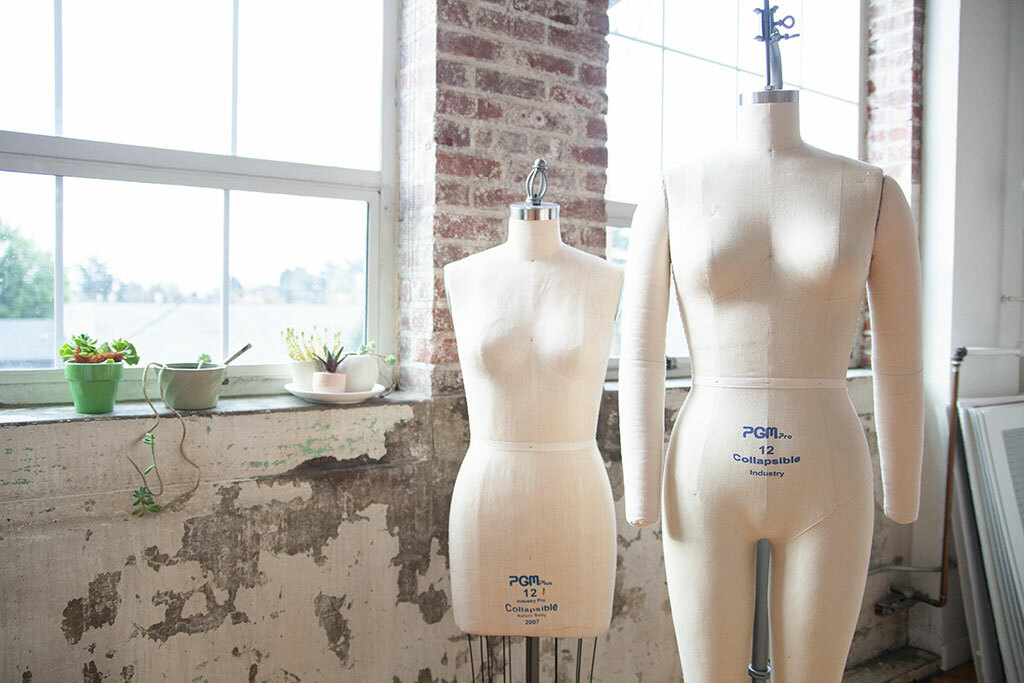
Sarai
Yeah, I kind of feel like I wouldn't use it that much for actually fitting or anything like that. I feel like it would be more for visualizing what things are going to look like. So doing some draping just to kind of see what things look like, how fabric falls on a body, that sort of thing. Maybe seeing if there's an extra detail I want to add. I can actually visualize what it's going to look like on the body before I decide whether to add it, that kind of thing. I feel like it would be it's definitely a nice to have, but I've never used them that much for fitting because it's just not the same.
Haley
Yeah, unless you invest in one of those custom forms which are really cool. I think that it's one of those things that, if I were you and I saw one of the yard sale, get it. But it is a nice to have, though.
Sarai
Yeah. I will say in terms of fitting, it is helpful for maybe a first pass and just seeing, is this the right size? That sort of thing. Are there any obvious problems? It's going to look different on a real life squishy human.
Haley
Always does.
Pain point: Your space is always cluttered and disorganized
Haley
All right, so our next set of tips is for if your sewing space is really cluttered or disorganized, you'll probably want to upgrade your storage because that's going to have really the most impact for you.
So something I'm always a huge advocate of is to look into long term storage and short term storage. I think that this is a really helpful way to kind of divide and conquer and figure out your specific needs.
Obviously, your long-term storage does not need to be nearly as accessible as your short-term storage is. And I feel like it makes the kind of beast of organizing feel so much easier when you break it down that way.
Like we mentioned earlier, looking for some more hidden storage options. We mentioned kind of creative places before, but even something like a dresser or a cabinet is really great. If you're someone who doesn't tend to keep, you know this about yourself, you don't keep things like super neatly folded and nice and tidy, then more hidden storage could be a really great option for you because you don't have to do that. I say, always lean into your natural tendencies.
If you're not super tidy, go for the hidden storage. But some people like to make their sewing space look like a fabric store. I have respect for those people.
Sarai
Me too.
Haley
I am not one of them. I like to choose my battles when it comes to being tidy and organized. But if you are one of those people, you can definitely look for things like open shelving bookshelves where you can really display all of your fabric and see it all in front of you. I think that can be really helpful creatively, just to know what you have. One thing to look out for though, is make sure that it's tucked away from daylight and you're not going to be bleaching your beautiful, precious fabric with the sun.
Sarai
Yeah, that's a lesson I've learned the hard way, unfortunately, in the past.
Haley
If you love that kind of open storage and displaying your things, you can play it a little bit safer and you can display your favorite tools, your favorite notions, even your thread on a. Nice little thread stand can be really, really helpful.
Another tip I have is to not neglect your smaller storage items. I think that we all tend to think of fabric and patterns, but also you have thread and you have buttons and make sure that you're not neglecting those things, because those things, I feel like, really contribute to that really overwhelming clutter because it's so much small stuff. You can get thread caddies. We use those at the office, and they're really great to just keep your thread organized and not like a huge tangled mess.
Sarai
And you can see what you have since they're clear.
Haley
Yeah, and you don't you're not like me, and you don't end up with, like, 50 spools of black thread.
In episode 102 of Seamwork Radio, we talk about the best storage methods for fabric specifically. So if that is really a big pain point for you, I definitely recommend checking out that episode.
Pain point: Your space doesn’t inspire you
Haley
And our last and final tip is, if your sewing space just does not inspire you, maybe you should take a moment, take a weekend, and personalize your space a little bit. Make it cute. You can paint it. I'm a big fan of painting. I feel like it has such a big impact, obviously a great way to add color. And I personally don't hate painting.
Sarai
I don't hate it either. I kind of like it.
Haley
Put on a podcast, paint, take a pizza break. It'll be done before you know it. You can listen to us.
Sarai
We'll be there.
Haley
We'll be there. Count us in.
Another thing you can do is you can get some curtains. Yes, you can sew them if your heart desires. You can use some fun fabric that's really going to inspire you and make your space feel really cheerful. This is a great way to—I think you can utilize this, too, if you don't have a devoted sewing space, to just make sure that you're bringing a little bit of cheer wherever it is that you sew, even if it's a kitchen nook.
Sarai
I have to say, when I moved in here, like I said before, this was a sewing space before we bought the home, and she had this, I don't know what you call it, sort of like a valence, but like a permanent one. It's like an upholstered wood valence that was covered in a sewing themed fabric with pin cushions and stuff. It was so not my style at all, but it was there for, like, the first year that we lived here. It was very thematic in here.
Haley
And if you love a theme, I say go for it.
But I think the most important thing is just making sure that it's something that makes you feel inspired, makes you feel happy. I think some people feel really inspired by an open, bright, neutral space where they can let their kind of thoughts and ideas run wild. And some people are inspired by lots of color and print.
Be honest to yourself about what you like and what you gravitate towards and make it happen for yourself.
Another really easy thing to make—this is my number one way to make any space just feel cooler—is just get a rug.
Sarai
Yeah, it's true. Rugs change things up.
Haley
Yeah. If you hate painting, you're like, Haley, I'm not going to do that, but I want color.
Sarai
You're crazy.
Haley
You're crazy. I don't want to do that. Go get yourself a rug. Even if you're on a budget. I've gotten plenty of rugs at the Goodwill. I highly recommend.
Sarai
I would recommend getting them cleaned, though, if you get a huge rug, because bugs are a real thing, especially if the rug is wool, you could be bringing them into your home.
Haley
I saw this hack somewhere on the Internet where someone, like, brought a rug to, you know, those, like, DIY car wash places where it has, like, the power washer hose, and they hung it up on the wall and power washed it.
Sarai
Whoa.
Haley
I'm very intrigued by that. That sounds very satisfying. But also, how are you going to get this sopping wet rug in your car?
Sarai
Oh, my goodness. That sounds very heavy and maybe smelly if it's wool, especially.
Haley
Yeah, that was a little segue, but yeah, get a rug. Add a little pop of color.
Another fun thing is to hang your sewing related stuff on your walls. You can hang up a mood board. You can frame some envelopes to vintage sewing patterns and display them. You can also display a quilt. I have both a mood board and a quilt in my sewing space.
Sarai
I have a mood board, and I want to hang up a quilt. It's one of my projects this year to make a wall quilt.
Haley
They're so satisfying. Such a fun little break from your regular sewing content.
Sarai
Very different.
Haley
Yeah, totally.
Recap
Sarai
All right, so those are our tips for you to help you revolutionize your sewing space, and hopefully you found something in here that's helpful.
So I'm just going to recap some of the issues you might encounter and some of the ways that you can address those issues.
If you don’t have enough space
So the first issue we talked about is if you don't have enough physical space and that's your biggest pain point, then what you want to do is make sure that you have things organized but still accessible. So we went over some ideas, like:
- Keeping things on carts, rolling furniture, foldable furniture, things with leaves.
- Making sure that your most frequently used tools and equipment are really easy to access. Access is the big thing there.
If you don’t have the right tools
The second issue that you might encounter is a lack of proper tools. So if that's your issue, we talked about some of the ways that you can adjust and update your tools that you have, including things like:
- Getting an adjustable-height table
- Getting a serger
- Pressing tools
- Maybe a dress form. Those are some great upgrades that you can do if you don't have them already.
If your sewing space is cluttered
The next one is if your sewing space is cluttered or disorganized. We talked about some ways to upgrade your storage.
- Think about long-term and short-term storage
- Hidden storage options are great ways that you can organize your stuff while keeping things kind of tidy and neat looking, depending on how much of that you need.
If your sewing space doesn’t inspire your
And then if your sewing space doesn't inspire you, we talked about some ways to personalize it, like:
- Painting
- Curtains
- Rugs
- Displaying your sewing stuff on the walls to make it feel more like you.
So those are some of the big pain points that we've seen from people and some of the ways that we think that you could address those pain points. So what's your big takeaway from this episode, Haley?
Haley
I think that my big takeaway is I think when it comes to creative folks like us, when it comes to our space, I think we tend to take an all or nothing approach sometimes. Like, I'm either going to redo the entire room or I'm just going to leave it as it is. And I like this approach of picking the thing that really is impacting you the most, stopping you from sewing and then solving that problem. It feels really approachable. I think that's actually just a really great approachable way to solve a lot of problems you may be having. It's good advice.
Sarai
It is good. It is good. I'm glad we thought of it. I agree.
And I think that's my big takeaway, too, is I'm going to step back and kind of think about how I can address—my biggest pain point right now is organizing a few specific things that don't have homes right now. For example, my paper sewing patterns are like, they're multiplying. I have a lot of plans right now, so I have a lot of them. I usually throw them out when I'm done or recycle them, rather, but right now they're just kind of piling up and I don't really have a place for them to live.
This is somewhat sewing related, but I have a lot of camera equipment and stuff and cords and things like that that are just floating around. They don't have a home. So thinking about the best way to address those specific issues instead of like, everything's a mess, this is never going to be better. Just kind of giving up, which that's been my approach so far, and that hasn't really worked.
Haley
Yeah.
Sarai
At least for cords. I feel like we all have those, like, hang up issues, and for me it’s cords.
Haley
Cords are always an issue.
Sarai
I don't know how you keep them organized and keep track of which chord is which. I don't know how anyone does it. How do you do it?
If you are interested in learning more about this, we actually have a free download called The Ultimate Guide to Setting Up Your Sewing Space. And this is a free mini-guide that has tons of tips and ideas like this for creating a better and more functional sewing area no matter how much space you have.
Just enter your email and we'll send it to you. And you'll have this really cool little PDF that will walk you through some of these tips and also has a lot of cool, inspirational images that might get your creative juices flowing.
And if you liked this episode, please consider leaving us a review. We love to hear what you think. So if you could leave us a review, or if you don't have time for a review, just leave us five stars on Apple podcasts or Spotify or wherever you happen to be listening to this, it really helps other people to find us, which we super, super appreciate.
That’s how people hear about the podcast is either you telling your friends about it or leaving us a review that other people can find it. So we really appreciate it and we have a review for us today that I wanted to share. And this is from I have it written here, but it's hard to read MJP Encinitas and this person says,
“Great podcast. I discovered this podcast in the last few months when I decided to start sewing clothes. I've been binging since then. The podcast made me think about how to plan what I'm going to sew, so I will actually wear the items I make. They talk about how to sew items that integrate into your wardrobe, when to buy and when to sew, et cetera. They talk about the basics of sewing, tools you need, threads to use, where to buy fabric, and which patterns to choose for your ability. Every podcast has a fun intro question that also teaches me new things. I also paid to join Seamwork and have been very satisfied with this. It's really fun to learn a new skill, and Seamwork makes it easy.”
Oh, what a sweet review. That is so nice.
Thank you so much for that review. We really appreciate it. I love reading the reviews. It's so heartwarming to see that people are enjoying the show. It just makes me feel like we're having a little conversation with you guys, which is so fun and that's why we're here.
So with that, we're going to sign off for today. I'm Sarai.
Haley
And I'm Haley.
Sarai
And this is Seamwork Radio.
